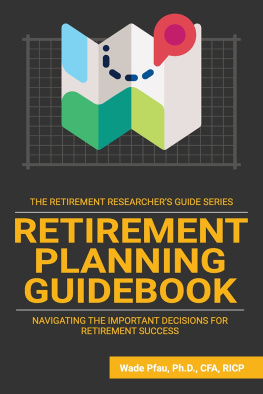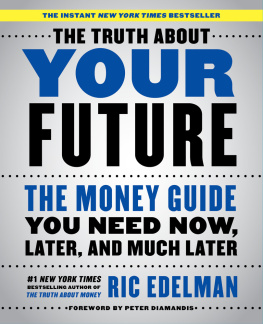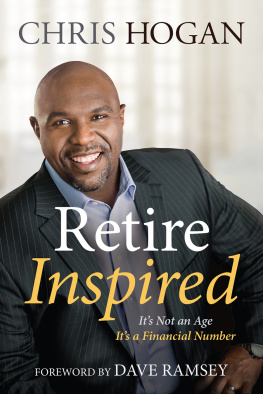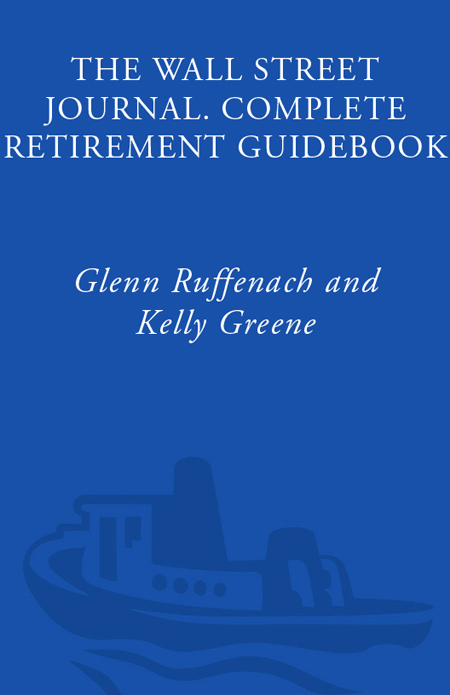
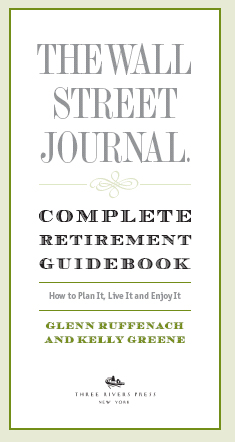
CONTENTS
PART I
RETIRE TO THE LIFE YOU WANT
CHAPTER 1
HOW DO I WANT TO SPEND MY TIME IN RETIREMENT?
CHAPTER 2
TO WORK OR NOT TO WORK?
CHAPTER 3
VOLUNTEERING IN RETIREMENT
CHAPTER 4
RELOCATION
CHAPTER 5
FITNESS AND HEALTH
PART II
MONEY MECHANICS
CHAPTER 6
BEFORE YOU OPEN THAT NEST EGG
CHAPTER 7
BUDGETING FOR RETIREMENT
CHAPTER 8
ASSETS AND BUCKETS
CHAPTER 9
PENSIONS, 401(K)S AND IRAS
CHAPTER 10
SOCIAL SECURITY AND MEDICARE
CHAPTER 11
LONG-TERM CARE STRATEGIES
CHAPTER 12
ESTATE PLANNING
FOR KAREN
FOR RICK
INTRODUCTION
Few events in our lives can produce as much satisfactionand as much anxietyas retirement.
We fantasize about the day when we finally can walk away from the duties and demands of our jobsand wonder if well miss our friends at the office. We make lists of things to do in retirementand worry whether our nest egg will be big enough to allow us to chase those dreams. We see ourselves aging gracefully in our home and the neighborhood that we loveand ask if poor health in later life will rob us of our independence.
If you find yourself with some or all of these thoughts, congratulations. You are perfectly normal. Survey after survey shows that most Americans are looking forward to retirement, but we arent sure if were ready or able to take the first step. In which case, it helps to have a plan.
The Wall Street Journal Complete Retirement Guidebook is just that: a blueprint for building a successful retirement. Like any good set of instructions, these pages will identify the tools you need to start: an understanding of how personal time, finances and relationships can change in later life. After that, well show you how the various piecessavings, Social Security, relocation, new careers, volunteer work, estate planning, health care, leisure and morecome together as you create your plan for a personally fulfilling retirement. Needless to say, this isnt the first book that has been written about retirement planning, and it wont be the last. With 78 million baby boomers now sporting more than a hint of gray in their hair, we can expect as many roadmaps to later life as there were guides to raising children in the 1950s. So far, most of these retirement books have focused either solely on the financial side of retirement or solely on lifestyles. Were going to take a different tack.
First, we address both money and time: how to organize your finances and your days in your fifties and beyond. After all, its almost impossible to answer the most frequently heard question among would-be retireesHave I saved enough money?unless you have some idea of how you plan to spend your time in retirement. Depending on your vision (A modest retirement close to home? Days filled with travel?), your nest egg might be more than sufficient or in need of major repairs.
Second, if many of us fail to consider how finances and lifestyles go hand-in-hand, its because we tend to regard retirement as an event, something that happens on a weekday afternoon. Actually, the best retirements are a process, one in which many decisions and refinements are made along the way. Thats the approach well take in this guide: looking at later life as a series of steps involving your lifestyle and finances. In doing so, we think you will end up with a more rewarding and productive retirement.
Only a few years ago, a guide like this would have been a tough selland a thin piece of work. From the 1950s through the early 1990s, retirement in the United States had much the same look and feel. A husband (and it was almost always the husband) collected a gold watch between the ages of sixty-two and sixty-five. He and his wife would spend about ten years at play and then ease toward their respective sunsets. Decisions and guesswork, for the most part, were kept to a minimum. Your former employer calculated what your pension would be and sent you a check every month. Uncle Sam did the same with Social Security. Some friends might move to Florida or Arizona, but nine out of ten older Americans stayed right where they were. The finish line for most was clearly marked: On Friday, you were working; come Monday, you were retired.
Today, in the space of a single generation, retirement for many has become a puzzlewith dozens of decisions and far too much guesswork. Four changes, in particular, have made the process more complicated: extended life spans, the demise of traditional pensions, womens entrance into the labor force, and the rising cost of medicine and long-term care.
Consider that the average sixty-five-year-old today can expect to live to age eighty-threeand spend almost two decades in retirement. Only about one in three Americans is covered by a defined-benefit pension plan; in other words, retireesand not their former employersare now shouldering the risks and responsibilities for creating a paycheck in later life. Almost 60 percent of women are working outside the home; thus, couples increasingly find themselves trying to plan and coordinate two retirements instead of just one. Meanwhile, health-care billseven for those covered by Medicarealready eat up one of every six dollars in Social Security benefits. The average cost of a one-year stay in an assisted-living center is about $35,600, according to MetLife; the average tab for a private room in a nursing home runs $75,200.
These changes mean that questions about later life now abound. When should I retire? Have I saved enough money? Will my nest egg last as long as I do? Do I want to, or need to, work in retirement (the new oxymoron)and if so, what jobs will be available? Can I continue to live at home? Will I need long-term care? And what about my spouse? Should both of us retire at the same time? Do we see later life and how to fill our days in the same light?
The pages that follow will speak to all these issues and more. To help simplify your planning, we divide retirementand our chaptersinto two parts. In Part One, we begin by talking about time: figuring out the life you want to lead in your fifties and beyond. Again, its hard to pinpoint how much money you need in retirement unless you first have a good idea of how you want to spend your days. Well also talk about working in retirement, volunteering, relocation and how to keep your mind and body healthy. In Part Two, we turn to finances: how to tap and preserve a nest egg, when to collect Social Security and how to create an estate plan (among other essential steps). Finally, we leave you with success stories profiles of individuals who successfully made the transition into fulfilling retirements.
The good news is that retirement today, for all its changes and challenges, appears to be more gratifying than ever before. We know this first-hand. In almost a decade of reporting and writing about retirement for The Wall Street Journal, we have interviewed hundreds of retirees, would-be retirees and former retirees from all parts of the country. The lessons they have shared about life after age fifty have proved invaluable for the Journals readers. We trust that these insights and experiences will be similarly useful to you.

Next page

